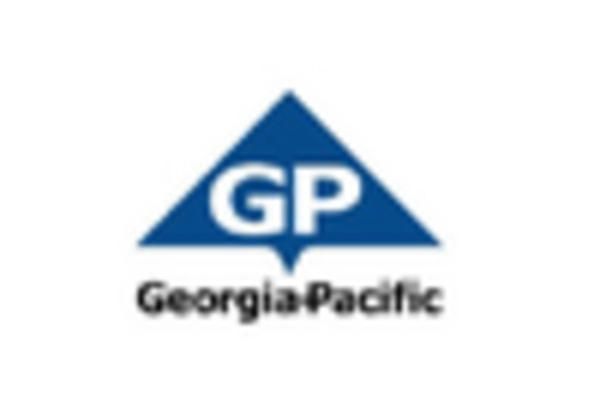Increased Awareness of Environmental Impact
The synthetic gypsum market is witnessing a surge in awareness regarding the environmental impact of construction materials. As stakeholders, including consumers and builders, become more informed about the ecological footprint of their choices, there is a growing preference for materials that minimize harm to the environment. Synthetic gypsum, being a byproduct of industrial processes, offers a sustainable solution that reduces landfill waste and conserves natural resources. This heightened awareness is reflected in market trends, with a reported increase of 15% in the adoption of synthetic gypsum in construction projects over the past year. The synthetic gypsum market is thus positioned to capitalize on this trend, as more companies seek to align their practices with environmentally responsible standards, potentially leading to a market growth of 7% annually.
Government Incentives for Sustainable Practices
The synthetic gypsum market is significantly influenced by government incentives aimed at promoting sustainable practices within the construction sector. Various federal and state programs offer financial support and tax breaks for projects that utilize eco-friendly materials, including synthetic gypsum. These initiatives encourage builders to adopt sustainable alternatives, thereby increasing the market's growth potential. For instance, the U.S. Department of Energy has implemented programs that facilitate the use of synthetic gypsum in energy-efficient building designs. As a result, the synthetic gypsum market is likely to benefit from these supportive policies, which could lead to a market expansion of approximately 10% over the next few years. This regulatory environment fosters innovation and encourages the adoption of synthetic gypsum in various applications, further solidifying its position in the construction materials landscape.
Technological Innovations in Production Processes
The synthetic gypsum market is benefiting from technological innovations that enhance production efficiency and product quality. Advances in manufacturing techniques, such as improved flue gas desulfurization processes, have led to higher yields of synthetic gypsum with reduced impurities. These innovations not only lower production costs but also improve the material's performance in applications like drywall and cement. The synthetic gypsum market is projected to see a growth rate of 6% as these technologies become more widely adopted. Furthermore, the integration of automation and data analytics in production facilities is likely to streamline operations, resulting in a more consistent supply of high-quality synthetic gypsum. This technological evolution is crucial for meeting the increasing demand from the construction industry, which seeks reliable and sustainable materials.
Rising Demand for Eco-Friendly Construction Materials
The synthetic gypsum market is experiencing a notable increase in demand driven by the construction industry's shift towards eco-friendly materials. As builders and developers prioritize sustainability, synthetic gypsum, a byproduct of flue gas desulfurization, emerges as a viable alternative to natural gypsum. This trend is underscored by the fact that synthetic gypsum can reduce carbon emissions by up to 30% compared to traditional materials. Furthermore, the synthetic gypsum market is projected to grow at a CAGR of approximately 5% over the next five years, reflecting the increasing preference for sustainable building practices. The integration of synthetic gypsum in drywall and cement production not only enhances the environmental profile of construction projects but also aligns with the broader goals of reducing waste and promoting recycling within the industry.
Growing Construction Sector and Infrastructure Development
The synthetic gypsum market is poised for growth due to the expanding construction sector and ongoing infrastructure development initiatives across the United States. With significant investments in residential and commercial construction, the demand for building materials, including synthetic gypsum, is on the rise. The market is expected to grow by approximately 8% as new projects are launched and existing structures are renovated. Additionally, government-funded infrastructure projects, such as highways and bridges, are likely to incorporate synthetic gypsum in their construction processes, further driving demand. This trend indicates a robust future for the synthetic gypsum market, as it aligns with the broader economic recovery and the need for sustainable building solutions in the face of increasing urbanization.

















Leave a Comment